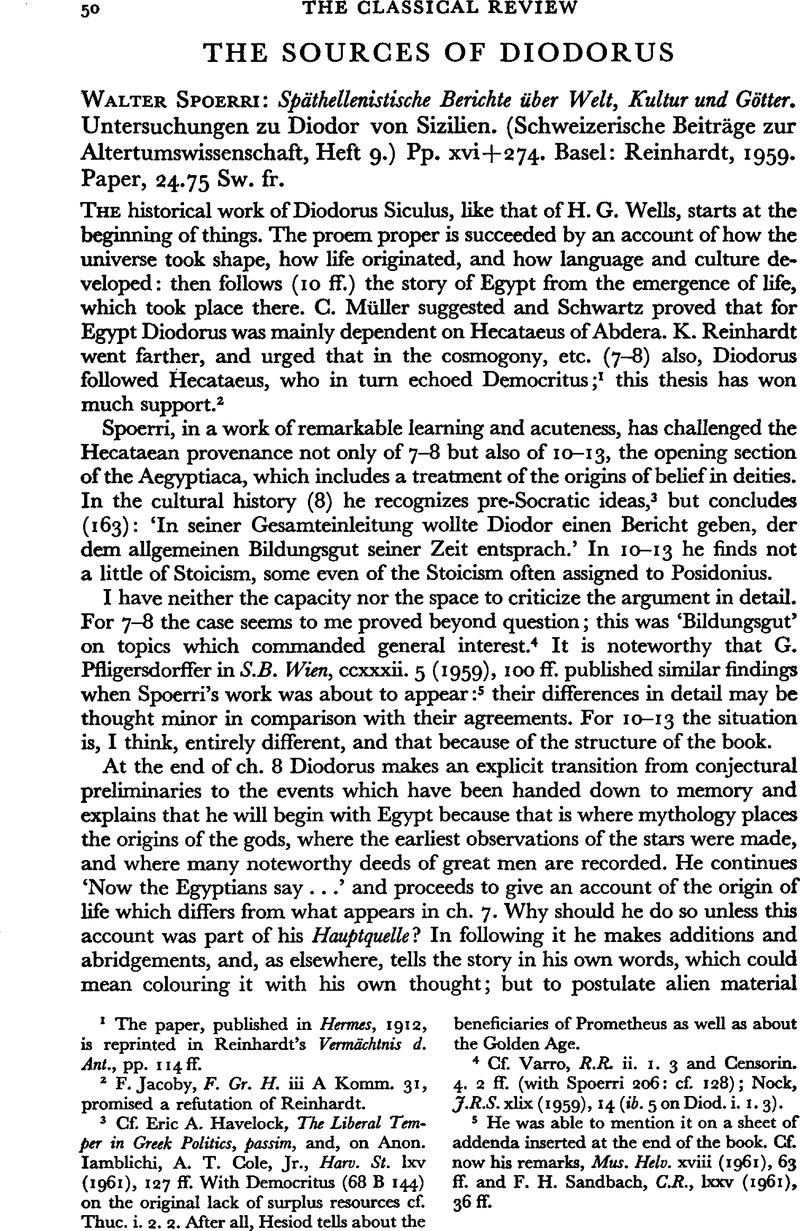No CrossRef data available.
Published online by Cambridge University Press: 27 February 2009

page 50 note 1 The paper, published in Hermes, 1912, is reprinted in Reinhardt's, Vermächtnis d Ant., pp. 114 ff.Google Scholar
page 50 note 2 F. Jacoby, F. Gr. H. iii A Komm. 31, promised a refutation of Reinhardt.
page 50 note 3 Cf. Eric A. Havelock, The Liberal Temper in Greek Politics, passim, and, on Anon. Iamblichi, Cole, A. T. Jr., Harv. St. lxv (1961), 127 ff.Google Scholar With Democritus (68 B 144) on the original lack of surplus resources cf. Thuc. i. 2. 2. After all, Hesiod tells about the beneficiaries of Prometheus as well as about the Golden Age.
page 50 note 4 Cf. Varro, R.R. ii. 1. 3 and Censorin. 4. 2 ff. (with Spoerri 206: cf. 128); Nock, , J.R.S. xlix (1959), 14Google Scholar (ib. 5 on Diod. i. 1. 3).
page 50 note 5 He was able to mention it on a sheet of addenda inserted at the end of the book. Cf. now his remarks, Mus. Helv. xviii (1961), 63 ff.Google Scholar and Sandbach, F. H., C.R., lxxv (1961), 36 ff.Google Scholar
page 51 note 1 γεννητοὺς in place of γενητοὺς has good manuscript authority (Cumont, J. Bidez-F., Mages hellénisés, ii. 68Google Scholar) and may be right; cf. Plat. Tim. 40 d. The two adjectives were, however, perhaps now synonymous: so Ps.-Plut. in Diels, Dox. gr. 296. 24 has γενητοῖς of the Olympians in contrast with the Titans.
page 51 note 2 So Schwartz, , Rh. M. xl (1885), 240 f.Google Scholar
page 51 note 3 It is hardly an accident that the ideas of Leon of Pella were associated with the fiction of a Letter of Alexander to Olympias. His scanty fragments do not say anything of celestial deities, but those of Euhemerus do. (Spoerri 190 insists rightly that Diod. vi. 1. 2 is not a quotation from E.: but Jacoby's arguments, P.–W. vi. 964, for the existence in E.'s scheme of a class of heavenly gods seem to me unshaken, and are reinforced by the facts about Uranopolis as presented by Tarn, , Alexander, ii. 429 ff.Google Scholar)
page 51 note 4 For pp. 170 ff., note Jessen's prehellenistic material for the idea of the sun as nourishing life (P.–W. viii. 61). The papyrus concerning Athena mentioned on p. 183, n. 24, has been restored by Adler, M., Charisteria Rzach, pp. 5 ffGoogle Scholar, as a laudation of the Graeco-Egyptian Athena (Neith), quoting Hermes ‘the greatest of the gods’: it is akin to P. Oxy. 1381.
page 51 note 5 Spoerri may well be right in denying 55, n. 10) that sect. 10 can in itself be regarded as attesting that Hecataeus equated Osiris and Isis with sun and moon: Diogenes certainly borrowed his parade of authorities from some intermediary or intermediaries, On the proem cf. now Gigon, O., Horizonte d. Humanitas, Freundesgabe W. Wili (1960), 37 ff.Google Scholar